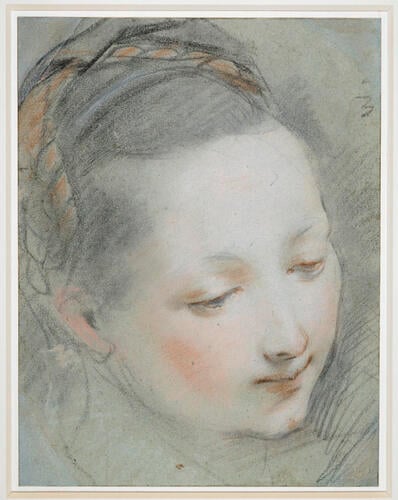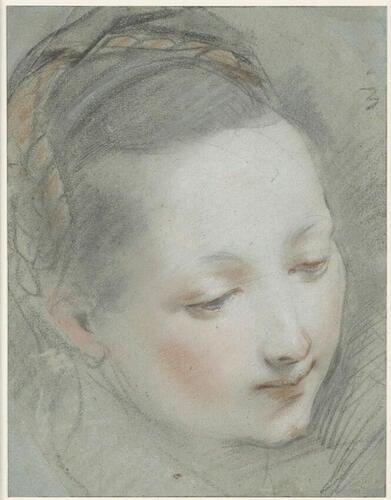-
1 of 253523 objects
The head of a young woman c.1582
Black, white and coloured chalks on blue paper | 29.9 x 23.0 cm (sheet of paper) | RCIN 905231

Federico Barocci (Urbino c. 1535-Urbino 1612)
The head of a young woman c.1582


-
A drawing of a head of a young woman, three-quarters right, her eyes directed downwards.
Popham (in P&W 1949) suggested this was a study for the woman on the left, pointing out the heavenly vision to her two children, in the Madonna del Popolo in the Uffizi. H. Olsen (Federico Barocci, 1962, p. 179) identified the drawing instead as a study for the Virgin in the Vatican Annunciation, and this identification has been generally accepted. There are differences in the hairline, and the features as painted are less delicately angular, but the attitude and expression are almost identical. The painting was executed between 1582 and 1584 for the chapel of Francesco Maria II, Duke of Urbino, in the basilica at Loreto. It was soon reproduced in prints - an etching by Barocci himself, and an engraving by Thomassin of 1588 - and thus became one of Barocci's best-known works. The painting was taken to the Vatican in the eighteenth century and replaced in Loreto by a mosaic.
Federico Barocci was the most innovative painter of altarpieces working in Italy in the later sixteenth century. He married the strong local colour and elaborate compositions of high Mannerism with intense observation from the life to produce a body of work unequalled among his contemporaries in its richness and variety. His influence would have been still greater had more of his paintings been readily accessible, but he was based in the small city of Urbino and many of his altarpieces were commissioned for provincial sites and thus were little known to artists working in the major centres.
A chronic illness restricted Barocci's artistic activity to short periods morning and evening, but despite (or maybe because of) this he prepared his compositions meticulously. Many hundreds of his studies survive, mostly in vigorous pen and wash or carefully blended chalks. For his head studies he exploited coloured chalks, both natural and fabricated, more extensively than any artist before the eighteenth century; this medium allowed him to determine both lighting and colour in the preparatory sheet, and thus he could use his precious painting time as efficiently as possible.
Provenance
Listed in George III’s ‘Inventory A’, c.1800-20, p. 124, ‘Frederico Barocci’, among ‘13. Of Study’s of Heads’ (905222-34)
-
Creator(s)
-
Medium and techniques
Black, white and coloured chalks on blue paper
Measurements
29.9 x 23.0 cm (sheet of paper)
Category
Object type(s)
Other number(s)
Alternative title(s)
The head of the Virgin